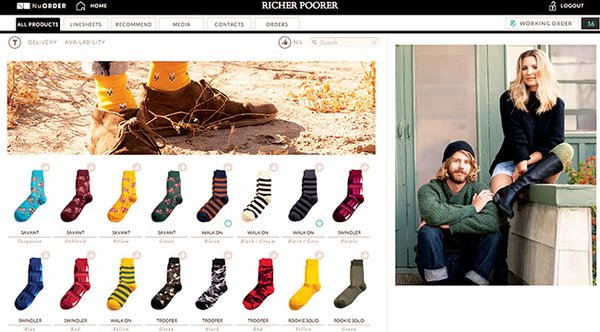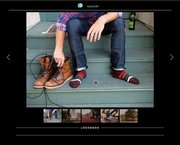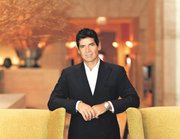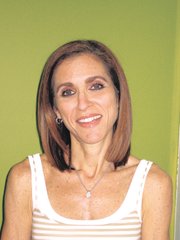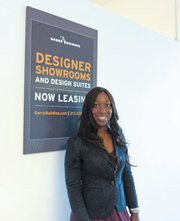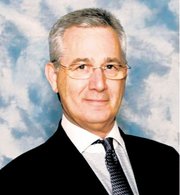With a recovering economy underway, trade shows are poised to see increased attendance in 2014. California Apparel News checked in with several trade show organizers to see what new programs they have in place to attract new and returning attendees. Some are expanding their buyer amenities and incentive programs. Others are offering retailers more opportunities to research the market before the show. And some are highlighting their seminar programs and entertainment offerings, or remerchandising the show floor and adjusting the schedule.
Tom Florio, Advanstar Fashion Group
Tom Florio
Chief Executive Officer
Advanstar Fashion Group
We’ve built a retailer-relations marketing team over the last two years. Pre-show, the relations marketing team is speaking to all the key retailers we do business with, really on an ongoing basis. If there are acquisitions going on, if there are new departments being launched—like a footwear department or a new men’s department—our retail-relations team is aware of it. As we’re walking around the world finding new brands, we’ll start feeding [retailers] brands. We’re working with them all the time, so there’s this ongoing dialogue. As we get closer to the show, certain retailers—particularly the larger ones—they’ll send us what it is they’re looking for, and we will start to plan their show for them.
We also have an overarching marketing campaign that markets MAGIC Market Week internationally. We don’t market MAGIC as a trade show; we market it as a contemporary market week for men’s, women’s and sourcing made up of 10 shows. There’s a multilingual direct-mail and advertising campaign that’s underway pre-show. Last show we had a 35 percent increase in our international buyers, and we’re also seeing an increase in e-commerce.
Each of the individual shows and the show directors have their own targeted database [and a] marketing campaign that goes out to special retailers [talking] very specifically about initiatives taking place on the show floor.
The other pre-show opportunity this year will be with Shop the Floor. All of our brands will have the opportunity to upload their looks on Shop the Floor about six weeks [before] the show actually starts, and our retailers will be able to go on Shop the Floor to preview collections, set up appointments and even do e-commerce if they want.
Even though everyone was running to the digital space, the idea of doing business in this space is a relatively new idea. I see Shop the Floor as an extension of MAGIC Market Week, which allows people to sell through business cycles. We’re pleased with the way it’s rolling out, but we’re surprised to see how comfortable people are in the traditional way of doing business—the brands as well as the retailers. It’s the fashion business—people want to speak to the people they do business with.
A lot of brands depend on the show. If you’re working with premium brands, they’re very protective about who sees their [collection]. Our system is a closed system. You’re only able to look at these sites if you’re a registered retailer at MAGIC Market Week and we really know who you are. We’ve added a mechanism, at the request of our brands, that [allows them to] select retailers because they want to decide what distribution channel they’re going to be in. At the last show, we went from 30-some-odd percent of our buyers using our apps and our digital platforms to 64 percent of them using our apps and our digital platforms. There seems to be some adoption, but it’s going to happen over time.
Overarchingly—and we get this from our post-show data—the No. 1 thing that drives retailers to a show, when you really cut to the chase on it, is they want to conveniently do business with the brands that they do business with. They want it to be easy to see the brands, and they want to be able to do commerce. The second thing they’re looking for is to see new brands.
Our show is made up—across all of our shows—of about one-third new brands to the show, and the remainder are [well-established] brands.
This is going to be particularly important this year. There’s a lot of talk about how promotional the holiday season will be. Buyers may be a little more cautious. They’re going to want to do business with brands they can trust, that they know will be behind them in case they don’t get the sell-throughs they want. New brands in those same environments with those existing brands have a better chance of being seen.
On the show site, there are a number of initiatives that take place. We have probably one of the largest seminar series at any trade show. It spans everything from sourcing to how to merchandise your booth. The education series continues to be a really big draw for the retailers.
And then there are show initiatives taking place across all the different platforms. An example would be at WWDMAGIC, there’s a trend report that takes place with Hal Rubenstein, the former fashion editor of Instyle.
Also, White, which is part of WWDMAGIC and moved out of the North Hall last year, will move back to the North Hall to make it easier for the buyers to get around.
Our whole initiative is to make it as convenient as possible for the retailers to shop across all our shows. Part of the way we’ve done that is the way we organize and curate and merchandise our shows. We continue to invest in what we refer to as “wayfinding” and attaching the wayfinding to transportation. The response from retailers in the last show [was] that it was much easier to get around the show.
We’re going to continue this evolution [by] setting up all of the MAGIC Market Week sites in an easily recognizable way. You can come off a bus or your town car and rather than just see the name of the show, you’ll be able to see womenswear is at the following shows, here are the classifications, [or], footwear is at the following shows, here are the classifications.
Olivia Reyes, California Market Center
Oscar Ben Rodriguez
Senior Trade Show Manager
Olivia Reyes
Trade Show Manager
California Market Center
In 2014, we will officially have Sunday starts for all LA Fashion Markets and corresponding trade shows at the CMC. We have shifted our market dates to better accommodate our attendees’ schedules, providing more-flexible times to visit, so they are not just during the week. We experimented with a Sunday start in October 2013, and it proved to be a success, so we look forward to continuing this through 2014.
We have increased concentration of resources under one roof. We are seeing significant crossover traffic among all types and categories of buyers in our building. We foresee this as a continued trend for the next year as creative merchandising in retail continues to upswing. Furthermore, in addition to our thousands of permanent resources in the building, we will continue to bring well-rounded groups of exhibitors to each of our trade shows, providing buyers with unmatched resources all in one place.
Through our continued travel program, our buyers will be able to take advantage of discounted hotel rates, complimentary shuttle services and other convenient benefits to make their travels to LA more enjoyable and easy.
We will continue to strive to create a productive and enjoyable shopping experience at the CMC to all our buyers through continued complimentary hospitality, Internet lounges, giveaways, special events, Market Tuesdays and much more. Furthermore, by continuing our partnerships with prominent industry forecasters and affiliates, we will be able to deliver insightful and relevant topics as a part of our ongoing retail seminars and discussion panels.
Andrew Olah, Kingpins Show and Olah Inc.
Andrew Olah
Founder/Owner
Kingpins Show
Chief Executive Officer
Olah Inc.
We are very excited about 2014. It is our 10-year anniversary, and it marks the debut of our first-ever European show, Kingpins Amsterdam, which is set to run May 7–8.
Every year we continue to tailor each show to meet the individual needs of the cities and markets we service, but one way that we boost attendance at every show is to offer seminars. Whether focusing on trends, finance, sustainability, cotton prices, the creative process or technical information for product development, we find that our attendees are highly motivated by information, education and inspiration.
So, beyond offering a better range of denim sourcing resources at every show, we also look to up the caliber and creativity behind our seminar offerings season after season.
Sam Ben-Avraham, Liberty Trade Fairs
Sam Ben-Avraham
Founder
Liberty Trade Fairs
As an individual show, our job is always to make sure we have all the relevant brands—a mix of the staples, fashion-forward and trend-based brands. It’s important to us that buyers see their existing accounts but also find something new at our show. At Liberty, we understand and live the market, and that’s what sets us apart from other shows.
We also understand one trade show cannot service every segment of the market without diluting its individual identity. This is why Liberty has aligned with other great shows with the same point of view, each an expert in its own market category. The Modern Assembly consists of Liberty, Capsule, Agenda and MRket and lives under one roof at The Venetian. We understand that our job is to service the industry and the buyers in the best way possible. By uniting, we’ve created one destination providing solutions to nearly every relevant store in the contemporary denim and designer category.
Judy Stein, Miami Swim & Lingerie Show
Judy Stein
Executive Director
Miami Swim & Lingerie Show
As always, we are tremendously excited about next year’s show. As you know, the Swimwear Association of Florida produces an annual four-day event titled SwimShow, which is the largest and most comprehensive swimwear trade show in the world. This event has made Miami Beach the No. 1 destination for the swimwear industry.
Each year, over 8,500 designers, buyers, manufacturers, press, and other industry leaders come to Miami Beach in the middle of July—not only to participate in this dynamic, valuable business opportunity but also to enjoy the hotels, nightlife, restaurants and entertainment aspects that this fun city has to offer. We host several programs during the event, including:
•Trend-forecasting seminar
Always on the cutting edge of industry insight and information, SwimShow will team with one of the world’s leading fashion and style-forecasting organizations to provide comprehensive trend reports for designers and buyers that will give them the vital advantage of an insider perspective. The seminar will dive into the latest trends seen on runways, trade shows, streets and retail shops and will pinpoint key beachwear concepts, colors, materials and details—all for the Cruise and Resort 2015 buying season—giving attendees an insight into the seasonal trend reports that will assist in reducing risk, saving time and making money.
•Fashion show and after-party
Each year, SwimShow generates wild enthusiasm for the upcoming Cruise/Resort season with the glamor of the highly anticipated runway show. The annual event will be held on-site in the [Miami Beach] Convention Center for the ease and convenience of our retailers and members. The SwimShow Fashion Show is a dazzling highlight, featuring a look from each of the participating brands in the trade show. It is an amazing lineup of the industry’s most exciting designers. The after-party is a great way to top off the evening with delicious bites, cocktails and entertainment.
•Swim lounge
SAF invites our members and buyers to relax and unwind in our luxurious swim lounge area. Replete with comfortable sofas and armchairs, the space is perfect to take a quick break or utilize the tabletop seating for a more discrete business conversation. Free Wi-Fi is available for all their needs. Plus, participants and retailers enjoy a Saturday and Monday evening happy hour from 6 to 7:30 p.m.
•Breakfast bar
The breakfast bar—featuring complimentary coffee, muffins and bagels—is open daily from 9 to 10:30 a.m. at the Convention Center and is the perfect way to start out each day.
•High tea
Featuring complimentary fresh fruit, biscotti and mini tea sandwiches, the high tea is the perfect way to add that afternoon kick.
• Informal modeling
This year the SwimShow will bring back informal modeling to the trade-show floor. Scheduled for each mid-morning of the show, this is a great way generate brand awareness and potential leads for participating swimwear companies.
• Design awards
We are also in the finalizing stages of announcing the First Annual SwimShow Design Awards, sure to be heralded as the “Oscars” of the swimwear industry. We will award recognition in the following areas: Swimsuit of the Year, People’s Choice Award, Best Full-Figured Suit of the Year, Best Active Wear of the Year, Best Girls’ Swimsuit of the Year, Best Men’s Swimsuit of the Year, Best Boys’ Swimsuit of the Year, Best Lingerie of the Year, Best Cover-up of the Year and Most Innovative Swimsuit of the Year. Products will be chosen from the samples that are sent for inclusion in the SwimShow runway show, and winners in each category will be announced at the end of the show.
•Social media
Last year’s social-media integration initiated interaction with buyers, exhibitors, media and swimwear lovers alike, reaching more than 1 million Twitter and Facebook users in just a few short weeks. We are in the process of developing this platform to become a comprehensive tool to build and grow our targeted attendees.
• International buyers
We have also partnered with the U.S. Commercial Service’s International Buyer Program to bring new international attendees to the show. The International Buyer Program recruits qualified foreign buyers, sales representatives and business partners in more than 80 countries to participate in U.S. trade shows each year.
•Media-sponsorship agreements
In addition, media-sponsorship agreements were generated with national and international publications that are considered to have the highest circulation and credibility within the swimwear and lingerie industry. Running in conjunction with our ongoing public-relations campaign, these publications will be running ads and featuring news stories about SwimShow on a regular basis.
Ed Mandelbaum, Designers and Agents
Ed Mandelbaum
Co-founder
Designers and Agents
D&A has been—and remains—the most significant trade-show destination in Los Angeles for the past 15 years and continues to present the strongest selection of both emerging and established brands as well as creating a great environment for both exhibitors and retailers to conduct business.
Designers and Agents also continues its longstanding commitment to sustainable, ethical and fair-trade design practices with its “green” programs, which provide support and exposure to those brands that meet the necessary criteria.
Pierre-Nicolast Hustel, CurvExpo
Pierre-Nicolast Hustel
Chief Executive Officer
CurvExpo
After a successful 2013 season, CurvExpo is very excited for 2014. It is important for us to keep the anticipation of each season high with new and exciting programs as well as retaining our loyal attendees and giving them reason to keep returning.
Our attendees are our priority. We have so many devoted attendees. It is important that we maintain our dedicated customer service and an all-inclusive experience. We are a focused team here at CurvExpo, and, as such, we can promise that all needs and/or concerns be met with tremendous care and a personal guarantee. We also offer our attendees an all-inclusive trade-show format. For example, we make the show feasible for our attendees by delivering a luxurious experience, offering breakfast and lunch; our partnerships with hotels can promise discounted rates; and, lastly, we can offer travel reimbursements (in Las Vegas only) to make the show as enjoyable as possible.
Further, we continue to keep our attendance high with insightful workshops for the buyers and trend seminars for the brands.
We continue to retain and attract our brands with an extensive marketing platform. We market our brands through all avenues of social media: Facebook, Twitter, Instagram (new this season) and Pinterest. We also have a dedicated newsletter issued every month to all our buyers that displays brand news and the lines they will see at the show. This year-round marketing platform starts the day a contract is signed and is a great tool for new brands to promote themselves in the industry and an extra boost for the established brands.
CurvExpo puts a lot of work into attracting new attendees with our brand partnerships and personal shopper services. We have great relationships with our brands that have proven mutually exclusive; as we help them, they help us to attract buyers they want to see on the show floor. Our personal shopper program gives the buyer a one-on-one experience with a member of our team. You tell us what you are looking for at the show, answer a quick questionnaire to help us understand your shop, and we will then consult and advise you on the best brands to visit during the show and who to book appointments with.
New to this season, we are thrilled to move forward with exclusive and informative events at each show, such as the Fashion Show and the Interactive Trend Wall. The Fashion Show will be an elegant event presenting fabulous lines in New York and Las Vegas. We are particularly enthusiastic for the new 8-by-15 Trend Wall, which will display fabrics, trends and lines from the brands on the show floor for a smarter shopping experience. This Trend Wall will be presented by Promostyl, and a consultant will be present to explain the benefits and how to use this to your advantage.
The highlight of 2013 was our New Accounts Program: “Love a new brand? Open a new account? Win a trip to Paris!” This program was a huge success at the shows, and we expect the same for the 2014 season. The program motivated buyers to “think out of the box” and search for a new brand. Likewise, the brands were excited as buyers were eager to meet them and work with them.
We have many reasons to keep our attendees coming back and much more to attract the new ones. CurvExpo is proud of the 2013 season, and we are working to grow and attract even more brands and buyers in 2014. We anticipate great shows for this season at both CurveNV Las Vegas Feb. 17–18 and at CurveNY New York Feb. 23–25.
Suzanne De Groot
Executive Director
Fashion Market Northern California
Fashion Market Northern California is fortunate to have many loyal buyers who come to all or many of our five shows a year.
That said, we are always looking for ways to encourage new buyers to come and enjoy the show and, of course, welcome anyone back who has not been to our market in a while.
We have recently hired a marketing consultant, who will focus on expanding our current website and Facebook and increasing our presence on other social-media venues. She will also be available at shows to demonstrate how to access and use social media as a selling tool—for both buyers and vendors.
We serve a complimentary breakfast buffet and lunch coupons to all buyers.
We have more than adequate (and easy) parking—with complimentary parking on Tuesdays at most shows.
We have extended our Monday hours to 7 p.m. and have wine and beer available during those hours, with complimentary drink coupons to buyers.
Every afternoon there is a complimentary cart with cookies and snacks, along with iced tea, lemonade and coffee.
We mail out a comprehensive show directory, linked to the website, which facilitates buyers making appointments in advance and planning their show time wisely.
We currently have a program to offer a complimentary night at the Marriott [San Mateo] to any first-time buyer who wishes to come to our show. This is time sensitive and subject to availability.
Mary A. Essuman, Gerry Building
Mary A. Essuman
Gerry Building
We like to do what we can to help the market.
We have a sign outside the building that lists the showrooms inside. That’s one way that attracts buyers for market We also have complimentary breakfasts during market.
For market, we’re always open to having temporary showrooms. We have several showrooms—between 10 and 15—with room for temporary showrooms.
We had a lot of temporary tenants come in for the Majors Market and some for the LA Market [in October]. We had a really good overall response—especially for our [opening-night] party.
This time around, we’ll be doing some other signage and flyers. We’d like to do some kind of promotional party similar to what we did [in October], although there may also be a fashion show on the roof in January.
David Lapidos, Offprice Show
David Lapidos
Executive Vice President
Offprice Show
We have instituted a loyalty program. Anyone who has attended any of our shows in the last two years will get a special rate at The Palazzo or The Venetian. Buyers will pay an Offprice rate of $199, which is $30 less than the hotel’s published rate. Also, we have increased our shuttle and limo business by 50 percent because we’re taking more people to more shows. As you know, there are a lot of shows that week. We are making a big step to accommodate everybody.
[We offer daily] New Buyer Tours. We take buyers out with a professional buyer [to tour the trade show]. He does this three times a day for the first two days and then once a day for the last day.
Also, we have upgraded our kosher food.
The last show was the first time we changed out floor plan, and people seemed very happy with it.
Our cash-and-carry section has mushroomed. We’ve got about 80 vendors.
Jeff Yunis
President and Owner of Specialty Trade Shows/organizers of WWIN (Womenwear in Nevada)
We’re one of the few that has not been affected [by the recession] Our show has been sold out for eight years. We just continue to do what we’re doing because we think it’s working.
We still do some snailmail and we do some emails and some faxes. And we get our exhibitors to work hard at making appointments and sending out information about the show to their clients. We put a lot of effort into making the exhibitors understand that it’s a partnership. When we send out an announcement mail, it’s propaganda. When they send it out, it’s one-on-one, seller to buyer. It’s a lot different when a store gets a call or mail from somebody they do business with trying to make an appointment than when they just get a blast email from us.
We give them free breakfast, free lunch, free snacks in the afternoon. But we have no room for seminars and fashion shows. It’s a show to do business. We impress upon buyers that this is a buying show. If they want to go sightseeing, they can go to the Grand Canyon or to MAGIC. If they don’t buy, the exhibitor has no reason to come back. We let people know they have to do their end of it. They just can’t show up and have a drink and schmooze and go home and send an order later. They’ve got to buy.
For that reason, we’ve got 855 booths at the show for the next show. We only have 19 left to sell, and our waiting list is half the size of the show.
We deal with specialty stores primarily. We do have Nordstrom and Ross Stores and TJ Maxx and all the catalogs [attending, as well]. But out of the thousands that come to the show, they make a small percentage. So we look after the small buyers. At our show, they feel they found a home, and that’s something we keep promoting. This is a place for specialty buyers. We make them feel very wanted. They never get pushed aside by big buyers walking by. When I used to go to MAGIC as a small buyer, the eyes were always out there looking for the big department store to walk by. At our show, that just doesn’t happen. The buyers tell us all the time that they feel comfortable, they feel at home. Everything we do is to make the buyers happy. Even though the exhibitors pay us, we realize that without the buyers we wouldn’t have the exhibitors. So we’re extremely buyer-oriented. That’s our way of doing business.
Aaron Levant
Founder
Agenda
We do a lot (to find new retailers). Our approach is multi-tiered. When we first started, it was [about] going out and banging on a lot of doors. We still keep that as part of the strategy today, 10 years later.
We have two people on the team who are dedicated to retail. They spend a couple weeks every season getting out there and going to retailers and meeting them personally. I personally go to a lot of retail stores. And everyone else on the team—we try to get to a lot of retail, especially in our backyard. We have to own our backyard and have that personal connection to people.
We do a lot of stuff with social media. I believe that we have the biggest presence in social media. That’s a big piece of what we do. It’s our generation.
We do a lot of unique print pieces and a multilayer email campaign and more traditional styles of marketing.
The No. 1 thing that we do that separates us from our other shows is our TAP program, which is our Targeted Attendee Program. And that is where we just spend money to help get key people out to the show. We basically poll our brands. They submit to us the retailers they would like to see the most. It isn’t just about buying power—buying power is definitely factored in—but also it could be influence.
It’s like a VIP program. It ranges from getting them hotel rooms to a car service to the show to flights. That is something we spend probably a considerable amount of the year on much more than other competitors.
Eva Walsh, Dallas Market Center
Eva Walsh
Vice President, Business Development
Dallas Market Center
Coming off one of the most successful markets of the year, we are so excited about what’s in store for Dallas Market Center in 2014. We are seeing firsthand a recovering economy with increases in attendance and significant growth across the apparel marketplace in the year-end, with many factors reinforcing these positive projections in the new year across all industries. In fact, many of the categories for our January Temp Show were sold out, and others more than 90 percent sold, long before the official start of the fall—one of the many encouraging signs we’ve seen leading up to the January Apparel Market in Dallas.
In addition to providing a diverse, complete product offering, we’ve continued to expand our programs to offer the resources and education our retailers need to succeed from a business standpoint. Our buyers come to market to gain the competitive advantage whether it’s access to the hottest lines and networking opportunities or the many inspiring fashion shows and displays. And most importantly, Dallas is all about helping retailers receive the highest return on investment possible—something that has been increasingly important the past few years. Whether they are new to Dallas or a 20-year veteran, attendees will feel good knowing Dallas is the most efficient marketplace proving to be a strong value year after year.
All of these focus points add up to big savings for attendees in 2014.
•Service
We have an entire department serving as retail ambassadors, working to secure new stores and serving loyal buyers. Our retail-development team works hard to understand a retailer’s business needs and provide support. While at market, buyers take advantage of a full suite of complimentary services, including Wi-Fi, on-site parking, shuttle service to and from area hotels, and hospitalities. Dallas equips buyers with critical information throughout the year relating to marketing, social media, prospecting, etc.
•Location
Location, location, location—we’ve heard it all before. Well, it really does matter after all. Dallas is conveniently located in Mid-America—the strongest economic region in the U.S. And the costs of doing business in Dallas are lower than any other marketplace, so it’s a more reasonable investment. With a broad array of leading manufacturers calling Dallas home, buyers get business done across many categories more efficiently.
•Travel
We’re determined not to let travel costs detract from our customer’s bottom line. Being at the center of it all, literally, Dallas offers more direct flights and the lowest hotel rates of any major marketplace (as low as $78 per night)—saving time and money.
Guglielmo Olearo, Première Vision
Guglielmo Olearo
International Exhibitions Director
Première Vision
It is our duty to stay very close to the market, [which is] why our U.S. office is in close contact with loyal and potential visitors.
We welcome most of the important companies, but we also expect that due to the recovering economy young designers and new brands with big creative potential will come to us.
We have the capacity to provide them with all the tools to find the best products for their collections.
We continually evaluate our show to meet buyers’ expectations in terms of the offerings and services. The rigorous selection of exhibitors means that professionals are sure of finding a truly creative and high-quality offerings.
Our fashion team creates seminars tailored to the North American market, and the trends are illustrated by products presented by our exhibitors. This is a truly unique service!
The fabric forum, with exhibitors’ samples, also gives a very clear vision of the [show’s offering].
Outside of the shows, we regularly provide attendees with fabric and fashion news.
Before the show we do everything we can to give visitors the key to a constructive visit, to inspire them and facilitate their business.


